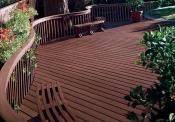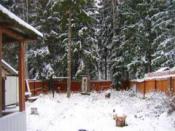Search
Login
Building a pool, how to build a pool of polypropylene do-it-yourself
Does it make sense to repeat how useful water procedures are for the body, especially swimming in the pool? These are: an increase in vitality, a good rest for the muscles of tired legs, restoration of the nervous system, a refreshing effect on hot summer days, or even just pleasure, especially for children. More and more owners of suburban areas are resorting to the construction of swimming pools, both open and indoor, with heated water, and allowing swimming throughout the year. In order for the pool to bring real pleasure, and its construction does not empty the pocket too much, it will be necessary to correctly select the appropriate material for the pool.
Content
- Polypropylene Pool - Pros and Cons
- Pool construction - how to choose the best form of construction
- How to install a polypropylene bowl for an outdoor pool
- How to build a pool of polypropylene sheets video
- A few tips for arranging and operating
Polypropylene Pool - Pros and Cons
One of the main advantages of this solution is the ability to purchase the product in its finished form and to install it independently in a previously prepared location. Moreover, installation and installation work does not take a lot of time, by the way it is this factor that often plays a decisive role.

In addition, the advantages of acrylic artificial ponds include the excellent quality characteristics of polypropylene:
- low level of heat and steam penetration,
- good heat-saving properties of the material make it possible to abandon the arrangement of a heat-insulating system - the material itself helps to maintain a certain temperature indicator of water for a long time, additional costs for heat-insulating materials, if any, are set, at the request of the owners,
- the possibility of obtaining savings on heating water - in a polypropylene construction only water will be heated.

Commercially available ready-made polypropylene pools allow you to make a product selection of any configuration, size, color. The surface of the polypropylene does not slip when wetted with water, the material has a sufficiently high strength and is resistant to a sharp increase in mechanical load. The pool bowl can be installed indoors or under a canopy, or in the open air - the material is resistant to ultraviolet rays, it is also not afraid of exposure to active chemicals, such as alkali or acid.
It’s easy to care for the surface of a polypropylene pond, while any detergents can be used - the color and brightness of the material will not be lost. The completeness of the appearance of the polypropylene surface allows you to do without tiling or decorative film. Resistance to high and negative temperatures allows you to operate the pool all year round - if you do not drain the water for the winter, then the open water can be used as a skating rink.
The service life of the polypropylene pool can be 20 years. It will take a little time to get the finished pool - from the order of the finished polypropylene bowl to its receipt and installation, it can take from two to four weeks.
Pool construction - how to choose the best form of construction
The issue of choosing a form can cause multiple disagreements in the family. The desire of the owners of the site is clear - to create something amazingly beautiful and unique, producing an indelible impression with its intricate shape.

Nevertheless, specialists and owners of artificial reservoirs with experience of care do not recommend choosing images from glossy magazines - complex forms will require more serious care, in addition, very accurate calculations of the installation location of the filter system will need to be performed, their capacity will need to be constantly adding to the water cleaning agents.

Agree, getting instead of pleasure a bunch of unnecessary problems and hassle is not very pleasant. The most acceptable shape for a home pool is rectangular, square or oval. To give the building originality, you can equip it, for example, with an unusual staircase, and perform original decoration of the territory adjacent to the pool.
How to install a polypropylene bowl for an outdoor pool
The installation procedure for a polypropylene bowl is not particularly different from the algorithm for creating a pool with a reinforced concrete bowl.
preparatory work
Before starting work, you will need to take measurements of the site, then - mark the place where the pool will be built:
- Choosing a place should be based on the type of soil and its slope on the site, the location of large trees - their roots can damage the walls of the pool, and falling leaves will cause permanent water pollution.
- Some savings can be obtained on a slope, a rational arrangement of the pool will help reduce the amount of excavation.
- If we take into account the prevailing wind direction in the area and correctly position the overflow pipes, then the leaves that fall into the pool will be able to independently leave its surface along with overflow waters, this will greatly simplify the process of cleaning the pool.
In accordance with the marking, a foundation pit is being rummaged - with your own hands, or with the help of special construction equipment - depending on the amount of work and on how good physical preparation the owners of the site have. Hiring workers with shovels - it makes no sense, at a cost the work will correspond to digging with the help of a machine, but its implementation time will be significantly extended.

It should be noted that the size of the pool and the pit should not coincide for it, the pit should exceed the size of the bowl itself, preferably 0.7 - 1 m. The depth of the pit should be about half a meter more than the depth of the bowl.
If there is a suspicion that groundwater lies close to the surface of the soil, then it will be necessary to build a drainage system.
foundation construction
The prepared bottom of the pit is lined with layers of rubble and sand, then a concrete base is formed under the pool. Reinforce concrete will help reinforcement mesh with a cell of 25 to 30 cm. The reinforcing mesh is installed at a height of 4-6 cm above the sand.

Having calculated the required amount of concrete, it is necessary to justify the feasibility of self-preparing it on the spot using a rented concrete mixer, but with large volumes it is easier to order ready-to-pour concrete.

The thickness of the finished concrete layer should be at least 30 cm.
bowl installation
After the concrete base has hardened, a polypropylene bowl is installed on it, communications are laid to supply and drain water, filter the liquid in the pool, and light. It is advisable to insulate each of the supplied pipes with protective sleeves, insulate and tape them with tape.

In accordance with the configuration of the pool, the number of installed drains, nozzles, and skimmers is calculated. You will also need to install a system for filtering water, the place of its placement may be the basement of the house.
Then it will be necessary to perform the insulation of the walls with foam, it is best to take the extruded material.
concreting the space around the walls of the pool
Lastly, the unfilled space between the walls of the bowl and the pit is concreted.

It is important to follow the sequence: first install a spacer inside the bowl itself, fill the pool with water to the recommended level. It is through it that concrete voids around the bowl will be filled with concrete. The walls of the pool installed in place are covered with foam sheets, stiffeners are drilled, pieces of reinforcement are inserted into the holes, they will increase the adhesion of the bowl to the concrete screed. recommended distance between fittings - from 50 to 70 cm.
Next, you can install the formwork and pour concrete. It is poured in stages, each subsequent layer - after the solidification of the previous one, about a day later. The thickness of the screed should be at least 30 cm. The water level in the tank should also be increased daily. Backfill is best done after filling is complete.
How to build a pool of polypropylene sheets
In the construction of the pool can also be used polypropylene sheet. For the construction of the bottom and walls of the pool, polypropylene sheets of different thicknesses are used. The connection of individual sheets is carried out by welding, the sheets are joined end-to-end, traces of seams on the surface are almost invisible.
Modern welding technology for polypropylene sheets allows you to make extremely durable seams that can guarantee integrity under all stresses on welded surfaces. The structural strength contributes to the active popularization of polypropylene pools.
The construction of the pool from sheets of polypropylene will require a drawing with a detailed indication of the dimensions. Based on it, it will be possible to calculate materials, in particular, the number of sheets of polypropylene.
In addition, you will need to acquire:
- welding extruder
- hot air gun
- nozzles on the extruder to make various seams.
Recommended polypropylene thickness for the construction of the bowl - from 8 mm. For the Roman stairs, you can use material with a thickness of 5 mm, bending 5 mm at a given angle will not be so difficult.

Welds are welded using an extruder, the principle of which is based on heating (using hot air) the surfaces of the fragments to be welded to certain temperatures and introducing a heated polypropylene rod into this zone, its temperature should be equal to the rate at which melting occurs. A polypropylene rod or granules of this material fuse the sheets, forming a very durable seam. This type of welding is used in the manufacture of pools, as well as for other installation work.
The cost of the extruder is quite high, it is not rational to purchase it specifically for the construction of one pool - it is best to look for an option to rent a device or purchase a unit that was already in operation, with its proposed sale upon completion of work.

Experts recommend assembling the bowl at the installation site of the pool, in which case it will not be necessary to expend energy on moving heavy and bulky structures. Before you start welding, the edge of the seams is cleaned, chamfering at an angle of 45 degrees. For maximum strength, it is recommended to use a double-sided overlay. If the material for filling the seams is selected successfully, then the seams, for the prying eye, will be almost invisible.
A pool made of polypropylene will need to be equipped with a ladder, it can be bought in a store ready-made or built independently. When making it yourself, you should not forget that the plastic strips 10-15 cm wide attached to the outside will serve as stiffeners and will ensure the preservation of the plane of the walls.
The full functioning of the bowl will require the installation of filtering and pumping equipment.
In the calculated points on the side walls of the pool bowl and on its bottom, drill holes of the desired diameter and secure the necks of pipes for various purposes:
- for water supply,
- for draining water
- for the connection of other communications.

Do not forget that all pipes need high-quality thermal insulation. For placement of auxiliary equipment, the basement of a structure located not far from an artificial reservoir is quite suitable.
The pool walls are insulated with foam sheets and concrete is poured from the outside of the bowl in exactly the same order as when installing the finished bowl.
At the end of concreting, the remaining space of the pit is covered with soil and compacted tightly. To get a comfortable, convenient for swimming and attractive in appearance pool should consider the option of the original and practical in the decoration of the surrounding space.
A few tips for arranging and operating
As for the care of the pool made of polypropylene, special brushes are used to clean it. Water in the tank should be replaced periodically with fresh. This procedure should be carried out systematically, even if the pond is not used for some reason. Stagnant water is an environment in which algae and harmful microorganisms will necessarily appear over time.

Maintenance is not a burdensome process; a variety of detergents can be used to clean it. To clean the surface of the water, use a special brush attached to the telescopic tube and connected by a hose to the skimmer.

For the convenience of users, you can embed cleaning, lighting, water heating, hydromassage systems.
If you follow these simple rules, then swimming will always be pleasant, and caring for an artificial pond will not be a particularly difficult process.





